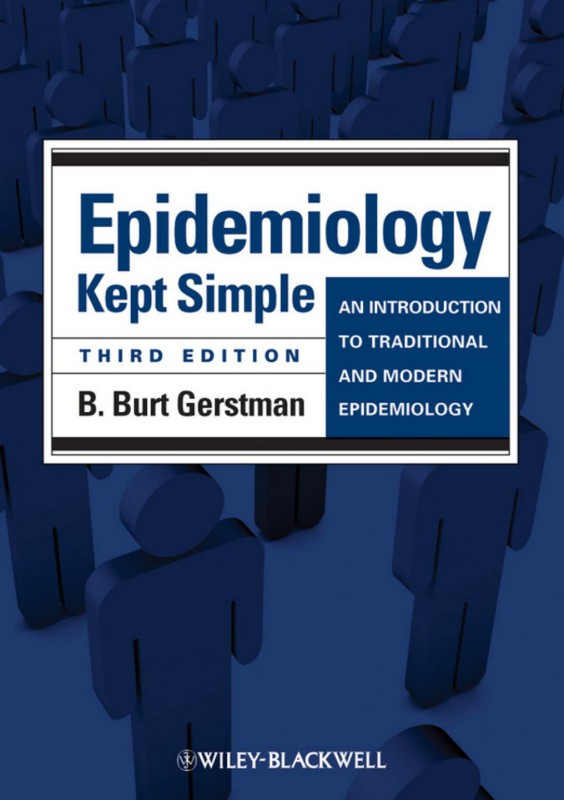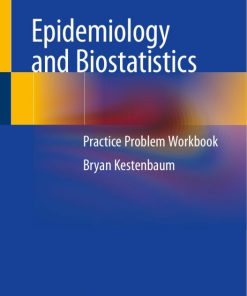Epidemiology Kept Simple An Introduction to Traditional and Modern Epidemiology 3rd Edition by Burt Gerstman ISBN 1118525418 9781118525418
$50.00 Original price was: $50.00.$25.00Current price is: $25.00.
Authors:B. Burt Gerstman , Series:Community Medicine [18] , Tags:Medical; Epidemiology; General , Author sort:Gerstman, B. Burt , Ids:9781444336085 , Languages:Languages:eng , Published:Published:Apr 2013 , Publisher:John Wiley & Sons , Comments:Comments:Epidemiology Kept Simple introduces the epidemiological principles and methods that are increasingly important in the practice of medicine and public health. With minimum use of technical language it fully explains terminology, concepts, and techniques associated with traditional and modern epidemiology. Topics include disease causality, epidemiologic measures, descriptive epidemiology, study design, clinical and primary prevention trials, observational cohort studies, case-control studies, and the consideration of random and systematic error in studies of causal factors. Chapters on the infectious disease process, outbreak investigation, and screening for disease are also included. The latter chapters introduce more advanced biostatistical and epidemiologic techniques, such as survival analysis, Mantel-Haenszel techniques, and tests for interaction. This third edition addresses all the requirements of the American Schools of Public Health (ASPH) Epidemiological Competencies, and provides enhanced clarity and readability on this difficult subject. Updated with new practical exercises, case studies and real world examples, this title helps you develop the necessary tools to interpret epidemiological data and prepare for board exams, and now also includes review questions at the end of each chapter. Epidemiology Kept Simple continues to provide an introductory guide to the use of epidemiological methods for graduate and undergraduate students studying public health, health education and nursing, and for all practicing health professionals seeking professional development.
Epidemiology Kept Simple An Introduction to Traditional and Modern Epidemiology 3rd Edition by Burt Gerstman – Ebook PDF Instant Download/Delivery. 1118525418, 9781118525418
Full download Epidemiology Kept Simple An Introduction to Traditional and Modern Epidemiology 3rd Edition after payment

Product details:
ISBN 10: 1118525418
ISBN 13: 9781118525418
Author: Burt Gerstman
Epidemiology Kept Simple introduces the epidemiological principles and methods that are increasingly important in the practice of medicine and public health. With minimum use of technical language it fully explains terminology, concepts, and techniques associated with traditional and modern epidemiology. Topics include disease causality, epidemiologic measures, descriptive epidemiology, study design, clinical and primary prevention trials, observational cohort studies, case-control studies, and the consideration of random and systematic error in studies of causal factors. Chapters on the infectious disease process, outbreak investigation, and screening for disease are also included. The latter chapters introduce more advanced biostatistical and epidemiologic techniques, such as survival analysis, Mantel-Haenszel techniques, and tests for interaction.
This third edition addresses all the requirements of the American Schools of Public Health (ASPH) Epidemiological Competencies, and provides enhanced clarity and
readability on this difficult subject. Updated with new practical exercises, case studies and real world examples, this title helps you develop the necessary tools to interpret epidemiological data and prepare for board exams, and now also includes review questions at the end of each chapter.
Epidemiology Kept Simple continues to provide an introductory guide to the use of epidemiological methods for graduate and undergraduate students studying public health, health education and nursing, and for all practicing health professionals seeking professional development.
Epidemiology Kept Simple An Introduction to Traditional and Modern Epidemiology 3rd Table of contents:
Chapter 1 Epidemiology Past and Present
1.1 Epidemiology and its uses
What is epidemiology?
What is public health?
What is health?
Additional useful terms
Uses of epidemiology
1.2 Evolving patterns of morbidity and mortality
Twentieth century changes in demographics and disease patterns
Mortality trends since 1950
Trends in life expectancy
1.3 Selected historical figures and events
Roots of epidemiology
John Graunt
Germ theory
M´edecine d’observation and La M´ethode Numerique (Pinel and Louis)
The London Epidemiological Society
William Farr
John Snow
Twentieth-century epidemiology
Emile Durkheim
Joseph Goldberger
The British Doctors Study
1.4 Chapter summary
Epidemiology and its uses
Evolving patterns of morbidity and mortality
Selected historical figures and events
Review questions
References
Chapter 2 Causal Concepts
2.1 Natural history of disease
Stages of disease
Stages of prevention
2.2 Variability in the expression of disease
Spectrum of disease
The epidemiologic iceberg
2.3 Causal models
Definition of cause
Component cause model (causal pies)
Causal web
Agent, host, and environment
2.4 Causal inference
Types of decisions
Report of the Advisory Committee to the U.S. Surgeon General, 1964
Hill’s framework for causal inference
Philosophical considerations
Exercises
Review questions
References
Chapter 3 Epidemiologic Measures
3.1 Measures of disease frequency
Background
Incidence proportion (risk)
Incidence rate (incidence density)
Prevalence
3.2 Measures of association
Background
Absolute versus relative comparisons
Absolute measures of effect
Relative measures of effect
Odds ratios
Relation between the RR and RD
3.3 Measures of potential impact
Attributable fraction in the population
Attributable fraction in exposed cases
Preventable fraction
3.4 Rate adjustment
Background
Direct adjustment
Indirect adjustment
Adjustment for multiple factors
Section summary
Notation used in Section 3.4
Exercises
Review questions
References
Addendum: additional mathematical details
Chapter 4 Descriptive Epidemiology
4.1 Introduction
What is descriptive epidemiology?
Case series
Surveillance systems
National health surveys and vital record systems
4.2 Epidemiologic variables
Person
Place
Time
4.3 Ecological correlations
Aggregate-level data
The ecological fallacy
Other types of aggregate-level variables
Exercises
Review questions
References
Chapter 5 Introduction to Epidemiologic Study Design
5.1 Etiologic research
Hypothesis statement
Variables
Data
5.2 Ethical conduct of studies involving human subjects
5.3 Selected study design elements
Necessity of a referent (“control”) group
Experimental versus observational study designs
Unit of observation
Longitudinal versus cross-sectional observations
Cohort versus case-control samples
5.4 Common types of epidemiologic studies
Exercises
Review questions
References
Chapter 6 Experimental Studies
6.1 Introduction
6.2 Historical perspective
Comment regarding use of the term “natural experiment”
6.3 General concepts
The control group
Randomization and comparability
Checking group comparability
Recruitment and eligibility criteria
Follow-up and outcome ascertainment
Intention-to-treat analysis versus per-protocol analysis
6.4 Data analysis
Measures of effect
Statistical inference
Sample size requirements
Exercises
Review questions
References
Chapter 7 Observational Cohort Studies
7.1 Introduction
7.2 Historical perspective
7.3 Assembling and following a cohort
7.4 Prospective, retrospective, and ambidirectional cohorts
7.5 Addressing the potential for confounding
7.6 Data analysis
7.7 Historically important study: Wade Hampton Frost’s birth cohorts
Exercises
Review questions
References
Chapter 8 Case-Control Studies
8.1 Introduction
8.2 Identifying cases and controls
Ascertainment of cases
Selection of controls
Number of controls per case
Sample size considerations
8.3 Obtaining information on exposure
8.4 Data analysis
Dichotomous exposure
Multiple levels of exposure
Matched pairs
Matched tuples
8.5 Statistical justifications of case-control odds ratio as relative risks
Incidence density sampling
Cumulative incidence sampling
Exercises
Review questions
References
Chapter 9 Error in Epidemiologic Research
9.1 Introduction
Random error and systematic error
Parameters and estimates
9.2 Random error (imprecision)
Probability
Introduction to statistical inference
Estimation (confidence intervals)
Hypothesis testing (p-values)
9.3 Systematic error (bias)
Selection bias
Information bias
Confounding
Exercises
Review questions
References
Chapter 10 Screening for Disease
10.1 Introduction
10.2 Reliability (agreement)
Essential background
The kappa statistic
The kappa paradox
10.3 Validity
Sensitivity and specificity
Predictive value positive and predictive value negative
True prevalence and apparent prevalence
Relation between prevalence and the predictive value of a positive test
Relation between prevalence and the predictive value of a negative test
Selecting a cutoff point for positive and negative test results
Key points
Reliability notation
Validity notation
Summary
Exercises
Review questions
References
10.4 Chapter addendum (case study)
Screening for antibodies to the human immunodeficiency virus
Further reading-screening for HIV
Further reading-general concepts of screening
Answers to case study: screening for antibodies to the human immunodeficiency virus
Chapter 11 The Infectious Disease Process
11.1 The infectious disease process
Agents
Reservoirs
Portals of entry and exit
Transmission
Host immunity
11.2 Herd immunity
What is herd immunity?
Stemming an outbreak through herd immunity
Epidemic modeling
Exercises
Review questions
References
Chapter 12 Outbreak Investigation
12.1 Background
Initial detection of outbreaks
Goals and methods of outbreak investigations
12.2 CDC prescribed investigatory steps
Step 1: Prepare for field work
Step 2: Establish the existence of an outbreak
Steps 3 and 4: Verify diagnoses of cases and search for additional cases
Step 5: Conduct descriptive epidemiologic studies
Step 6: Develop hypotheses
Steps 7 and 8: Evaluate hypotheses; as necessary, reconsider or refine hypotheses and conduct additi
Step 9: Implement control and prevention measures
Step 10: Communicate findings
Review questions
References
Drug-disease outbreak
Answers to case study: a drug-disease outbreak
References-a drug-disease outbreak
Food borne outbreal in Rhynedale, California
Answers to case study: food-borne disease outbreak
Chapter 13 Confidence Intervals and p-Values
13.1 Introduction
Parameters and estimates
Population and sample
Statistical inference
13.2 Confidence intervals
Estimation
Confidence intervals for proportions (incidence proportion and prevalence)
Confidence intervals for rates
Confidence intervals for proportion ratios (risk ratios and prevalence ratios)
Confidence intervals for rate ratios
Confidence intervals for proportion differences (risk differences and prevalence differences)
Confidence intervals for rate differences
Confidence intervals for odds ratios, independent samples
Confidence intervals for odds ratios, matched pairs
13.3 p-Values
Hypothesis tests of statistical significance
Fallacies of p-values and statistical testing
Testing a proportion
Testing a rate
Chi-square test of association
Fisher’s exact test
Testing independent rates
McNemar’s test for matched pairs
13.4 Minimum Bayes factors
Introduction
Bayes factor
Interpretation of the Bayes factor
Prior odds
Method to calculate a minimum Bayes factor
References
Chapter 14 Mantel-Haenszel Methods
14.1 Ways to prevent confounding
14.2 Simpson’s paradox
14.3 Mantel-Haenszel methods for risk ratios
Mixing of effects
Homogeneity assumption
Mantel-Haenszel summary risk ratio
Confidence interval for the Mantel-Haenszel risk ratio
Mantel-Haenszel test statistic
14.4 Mantel-Haenszel methods for other measures of association
Differences between proportions (incidence proportion difference and prevalence difference)
Odds ratios
Rate ratios
Rate differences
Test statistic for stratified person-time data
Exercise
References
Chapter 15 Statistical Interaction: Effect Measure Modification
15.1 Two types of interaction
Types of interaction
Biological interaction
Statistical interaction
15.2 Chi-square test for statistical
15.3 Strategy for stratified analysis
Exercises
References
Chapter 16 Case Definitions and Disease Classification
16.1 Case definitions
Establishing a case definition
Multiple-choice criteria
Chronic fatigue syndrome, as an example
Evolution of the AIDS case definition, as an example
Classification of case status based on certainty
16.2 International classification of disease
16.3 Artifactual fluctuations in reported rates
16.4 Summary
References
Chapter 17 Survival Analysis
17.1 Introduction
17.2 Stratifying rates by follow-up time
17.3 Actuarial method of survival analysis
17.4 Kaplan-Meier method of survival analysis
17.5 Comparing the survival experience of two groups
Risk differences and risk ratios at selected points in time
Comparing survival functions as a whole
Cochran-Mantel-Haenszel chi-square statistic
Exercises
References
Chapter 18 Current Life Tables
18.1 Introduction
18.2 Complete life table
Predicting probabilities from rates
Special circumstances surrounding the first year of life
General formula
Constructing a complete life table
18.3 Abridged life table
Exercises
References
Chapter 19 Random Distribution of Cases in Time and Space
19.1 Introduction
19.2 The Poisson distribution
Use of the Poisson formula
Calculating the expected number of cases
Post hoc identification of clusters
19.3 Goodness of fit of the Poisson distribution
Fitting the Poisson distribution
19.4 Summary
Exercises
References
Answers to Exercises and Review Questions
People also search for Epidemiology Kept Simple An Introduction to Traditional and Modern Epidemiology 3rd:
epidemiology kept simple
epidemiology kept simple pdf
7 uses of epidemiology
uses of epidemiology pdf
epidemiology simple terms
You may also like…
eBook PDF
Epidemiology A Very Short Introduction 1st Edition by Rodolfo Saracci ISBN 019954333X 9780199543335
eBook PDF
An Introduction to Orthodontics 3rd Edition by Laura Mitchell ISBN 0198568126 9780198568124
eBook PDF
Clinical Epidemiology of Orthopedic Trauma 1st Edition by Yingze Zhang ISBN 9783131660411 3131660414












